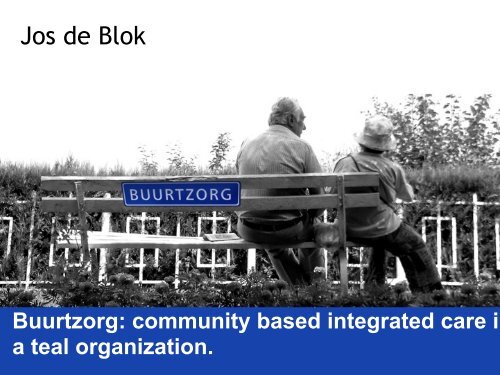Jos de Blok
Buurtzorg-england-July2015
Buurtzorg-england-July2015
- No tags were found...
Create successful ePaper yourself
Turn your PDF publications into a flip-book with our unique Google optimized e-Paper software.
<strong>Jos</strong> <strong>de</strong> <strong>Blok</strong><br />
Buurtzorg: community based integrated care in<br />
a teal organization.
Buurtzorg – Quick Scan<br />
• New organization and care <strong>de</strong>livery mo<strong>de</strong>l<br />
• Started in 2007 with 1 team/4 nurses<br />
• Delivering Community Care/working together GP’s<br />
• 2015: 9500 nurses in 800 ‘in<strong>de</strong>pen<strong>de</strong>nt’ teams.<br />
• 45 staff at the back office and 15 coaches<br />
• 70.000 patients a year
Results policy on homecare 2006<br />
• Fragmentation of cure, care, prevention<br />
• Standardization of care-activities<br />
• Lower quality / higher costs: wrong incentives:<br />
<strong>de</strong>livering much care against low cost is profitable<br />
• Big capacity problems due to <strong>de</strong>mographic<br />
<strong>de</strong>velopments (shortage of 400.000 nurses within<br />
10 years<br />
• Clients confronted with many caregivers<br />
• Information on costs per client/outcomes: none!
Start Buurtzorg 2007<br />
Starting an organization and care <strong>de</strong>livery mo<strong>de</strong>l<br />
for community care with:<br />
– in<strong>de</strong>pen<strong>de</strong>nt teams of max 12 nurses<br />
– Working in a neighborhood of 5000-10.000 p.<br />
– who organize and are responsible for the<br />
complete process:<br />
• clients, nurses, planning, education and finance;<br />
• and all kind off coordination activities!!!!<br />
• Integrating nursing/medical and social care
Vision: support in<strong>de</strong>pence!<br />
4. Formal networks<br />
3. Buurtzorgteam<br />
2. Informal networks<br />
CLIËNT<br />
1. Selfmanagement client<br />
Onionmo<strong>de</strong>l Buurtzorg<br />
Buurtzorg works insi<strong>de</strong>-out:<br />
empowering and adaptive,<br />
networkcreating, supporting.
(Self)-Organisation<br />
• Optimal autonomy and no hierarchy: TRUST<br />
• Complexity reduction (also with the use of ICT)<br />
• Max of 12 nurses a team, 40 à 50 clients<br />
• Generalists: taking care for all type of patients<br />
• 70% registered nurses/40% bachelor <strong>de</strong>gree<br />
• Their own education budget<br />
• Informal networks are much more important than formal organizational<br />
structures<br />
• Training SIM: selfsteering and coaching
Different types of clients<br />
• Chronically ill and functionally disabled clients<br />
• El<strong>de</strong>rly clients with multiple pathology<br />
• Clients in a terminal phase<br />
• Clients with symptoms of <strong>de</strong>mentia<br />
• Clients who are released from the hospital and are<br />
not yet fully recovered
Quality system<br />
• Monitoring outcome instead of production: the<br />
Omaha system<br />
• Roles and activities instead of processes (DK)<br />
• High education level: 70% is RN (average 10%)<br />
• And of course: clientsatisfaction!
Supporting the in<strong>de</strong>pen<strong>de</strong>nt teams<br />
• 45 people in 1 back office; 15 coaches, managers<br />
0!<br />
• Taking care of inevitable bureaucracy, so the<br />
nurses won’t be bothered with it!<br />
– The care is charged.<br />
– The employees are paid<br />
– Making financial statements
ICT makes it possible! - Buurtzorgweb<br />
Shared values<br />
View on quality of care,<br />
transparency<br />
Position in the care-chain,<br />
relationship whit other caregivers.<br />
Grip on the business<br />
Community<br />
Instruments<br />
Communitatio<br />
n in the care<br />
chain<br />
Production<br />
Relationshi<br />
p<br />
profession<br />
al and<br />
client
Buurtzorgweb – some aspects<br />
• Community<br />
• Clients and employees data<br />
• Hour registration.<br />
• Sharing documents<br />
• All the necessary administration for accountability<br />
to cost provi<strong>de</strong>rs, inspection etc.<br />
• Planning
Community<br />
• Shared values. Nurses work all over the country but<br />
feel like ‘one’<br />
• Nurses can ask for good examples from colleagues<br />
all over the country.<br />
• Man. Dir. can easily check the i<strong>de</strong>as of the teams<br />
• The back office has an easy way of communication<br />
with all the nurses<br />
• Contact between nurses and informal care and<br />
other caregivers from the neighborhood
Buurtzorg is Dutch most fast growing<br />
organization<br />
Started in 2007<br />
2015: 8000 nurses in 800 teams
Buurtzorg in the whole country
New theoretical mo<strong>de</strong>l?<br />
Fre<strong>de</strong>ric Laloux: reinventing organizations:<br />
• Selfmanagement<br />
• Wholeness<br />
• Evolutionairy purpose<br />
Sharda Nandram: Integrating simplification<br />
• Needing principle<br />
• Rethinking principle<br />
• Common sense principle
Satisfied employees<br />
• Thousands of nurses quit their job at traditional<br />
organization and went to work for Buurtzorg<br />
• They appreciate:<br />
– Working in small teams<br />
– Working autonomous<br />
– In<strong>de</strong>pen<strong>de</strong>ncy<br />
– Strong teamspirit<br />
– User-friendly ICT<br />
• Price for best employer 2011/2012/2014/2015?
Satisfied clients<br />
• Good quality of care.<br />
• "Compaired to 307 other organizations for<br />
community care they give the highest score to<br />
Buurtzorg. (NIVEL 2009)“<br />
• Highest clientsatisfaction rates: 9,1<br />
• Supported by patient- and el<strong>de</strong>rly organizations<br />
• Less admissions in hospitals and nursinghomes
Radio Steunkous
Rollatorrace<br />
http://<br />
www.youtube.co<br />
m/watch?v=QfPDrN5pBU
Cost effectiveness for the organization<br />
• Overhead costs: 8% (average 25%) ! more money<br />
for the care and innovation<br />
• Profit rate: 4%<br />
• Sickness rate: 4% (average 6%)
Cost Benefits for the Care!<br />
• The home care would be 65% of the costs (Buurtzorgs<br />
mo<strong>de</strong>l leads to more prevention, a shorter period of care and<br />
less spending on overhead)<br />
• More satisfied employees and clients<br />
• The government an all political parties are stimulating other<br />
care organization to work like Buurtzorg.<br />
• Other sectors are interested in the organization mo<strong>de</strong>l
Is England ready for a transition?<br />
• There are persistant problems in health care:<br />
• - quality: fragmentation<br />
• - <strong>de</strong>mografic and costs: exploding?<br />
• - human capital: frustrated professionals<br />
• Problems can’t be solved with current solutions<br />
• There is awareness for alternative solutions<br />
• We are in a change of era’s<br />
• You already started!
Thank you for your attention


